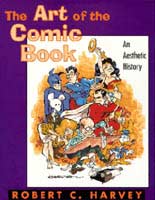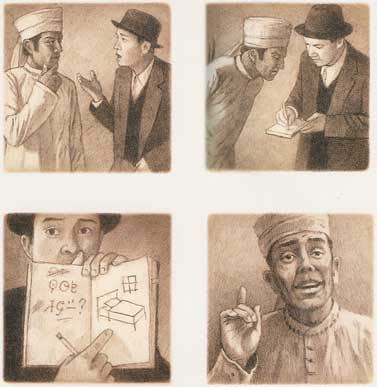A Few Words on Wordlessness
 In The Art of the Comic Book (University Press of Mississippi, 1996), R. C. Harvey states: "A cartoonist is one who creates in the visual-verbal mode of the comics--someone who is a writer-artist. And in the creative processes of the cartoonist, neither words nor pictures take precedence over the other: they blend."
In The Art of the Comic Book (University Press of Mississippi, 1996), R. C. Harvey states: "A cartoonist is one who creates in the visual-verbal mode of the comics--someone who is a writer-artist. And in the creative processes of the cartoonist, neither words nor pictures take precedence over the other: they blend."
Harvey is expert in cartooning, comics history, and literary analysis, and this is a very good book on the form. However, his attempt to locate the essence of the comics art form in a half-and-half blend of words and pictures is untenable. (Dylan Horrocks has complained that Harvey's adherence to this theory leads him into "some rather asinine critical judgements." I wouldn't go that far, not when I can simply link to Horrocks's essay.)
The most obvious problem with Harvey's hypothesis is that it offers no space for wordless comics. He acknowledges that some exist, offering an example from a daily strip, but treats them as exceptional. Most comics creators and readers would probably say that comics without words and comics with them share more qualities than not. Both are sets of sequential pictures, they usually adopt the same visual vocabularies and techniques, and we interpret them through similar processes.
Shaun Tan's wordless The Arrival was one of the 2007 Cybils finalists in the graphic novels category (older readers division). I think its wordlessness is crucial to how it works, as I plan to discuss tomorrow. Tan even includes an episode about communicating through pictures instead of words:

The label "wordless" seems to mean something different when applied to children's picture books. As Scholastic published Sara Varon's Chicken and Cat in 2006, the catalogue copy labeled it a "wordless picture book." Booklist and The Horn Book echoed that label. School Library Journal called it a "wordless story." But the book contains words, as this detail from one spread shows. In fact, out of sixteen page spreads in Chicken and Cat, ten contain words. Some are labels on shops, products, or structures that appear in the scenes (e.g., on the seed packets in the picture above). Others are sound effects and motion labels (e.g., "pat pat pat"), as I described back here.
In fact, out of sixteen page spreads in Chicken and Cat, ten contain words. Some are labels on shops, products, or structures that appear in the scenes (e.g., on the seed packets in the picture above). Others are sound effects and motion labels (e.g., "pat pat pat"), as I described back here.
Chicken and Cat got labeled as "wordless" because it doesn't have words where most picture books do. There's no narration explaining the scenes and the transitions between them. As with truly wordless picture books, an adult can't read it aloud to a child. And of course adults need some sort of warning.
Varon's Robot Dreams was another Cybils graphic novel finalist this year. It, too, was described by its publisher as "without words," but again it has a few. Unlike The Arrival, however, that seems simply to reflect Varon's storytelling style; it's not thematically linked to the book's story.


No comments:
Post a Comment